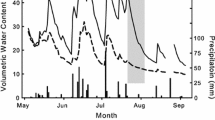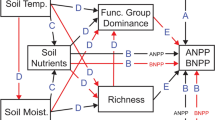Abstract
Over the past century at the National Bison Range, temperature has increased by 0.6 °C, and annual precipitation has decreased by 26%, despite increases in May–June precipitation over the past 35 years. Limited experimental work to date has explored plant responses produced by the interaction of changes in both temperature and precipitation, and of the existing studies, none have focused on the endangered bunchgrass ecosystem. Using a 2-year climate change manipulation experiment, we show that bunchgrass productivity increased with supplemental growing season precipitation, while warming alone exerted no significant effect. More importantly, the ratio of June precipitation to minimum temperature, a representation of the interaction of climate variables, predicted bunchgrass productivity better than either climate variable individually. This ratio acted as a surrogate index reflecting increased evapotranspiration with rising temperatures and thus better predicting soil moisture available for plant growth. Experimental warming over the summer led to significantly lower plant species richness and biodiversity, while increased precipitation, when applied over the entire summer, counteracted some of these declines. Warming also led to greater and more rapid plant senescence over the summer, resulting in greater litter production [an increase of 47.82 ± 17.82 (± SE) percentage points] and potential fire risk. Given the simultaneous changes in precipitation and temperature predicted for the next century, multi-factor experiments are essential to understand how ecosystems will respond to future climate scenarios.



Similar content being viewed by others
References
Aronson EL, McNulty SG (2009) Appropriate experimental ecosystem warming methods by ecosystem, objective, and practicality. Agric For Meteorol 149:1791–1799. https://doi.org/10.1016/j.agrformet.2009.06.007
Cardinale BJ, Duffy JE, Gonzalez A, Hooper DU, Perrings C, Venail P, Narwani A, Mace GM, Tilman D, Wardle DA, Kinzig AP, Daily GC, Loreau M, Grace JB, Larigauderie A, Srivastava DS, Naeem S (2012) Biodiversity loss and its impact on humanity. Nature 486:59–68. https://doi.org/10.1038/nature11148
Chapin FS III, Zavaleta ES, Eviner VT, Naylor RL, Vitousek PM, Reynolds HL, Hooper DU, Lavorel S, Sala OE, Hobbie SE, Mack MC, Díaz S (2000) Consequences of changing biodiversity. Nature 405:234–242. https://doi.org/10.1038/35012241
Cleland EE, Chuine I, Menzel A, Mooney HA, Schwartz MD (2007) Shifting plant phenology in response to global change. Trends Ecol Evolut 22:357–365. https://doi.org/10.1016/j.tree.2007.04.003
Collins SL, Koerner SE, Plaut JA, Okie JG, Brese D, Calabrese LB, Carvajal A, Evansen RJ, Nonaka E (2012) Stability of a tallgrass prairie during a 19-year increase in growing season precipitation. Funct Ecol 26:1450–1459. https://doi.org/10.1111/j.1365-2435.2012.01995.x
Daubenmire RF (1947) Plants and environment: a textbook of plant autecology. Wiley, New York, NY
Dukes JS, Chiariello NR, Cleland EE, Moore LA, Shaw MR, Thayer S, Tobeck T, Mooney HA, Field CB (2005) Responses of grassland production to single and multiple global environmental changes. PLoS Biol 3:e319. https://doi.org/10.1371/journal.pbio.0030319
Fay PA, Blair JM, Smith MD, Nippert JB, Carlisle JD, Knapp AK (2011) Relative effects of precipitation variability and warming on tallgrass prairie ecosystem function. Biogeosciences 8:3053–3068. https://doi.org/10.5194/bg-8-3053-2011
Flanagan LB, Sharp EJ, Letts MG (2013) Response of plant biomass and soil respiration to experimental warming and precipitation manipulation in a northern Great Plains grassland. Agric For Meteorol 173:40–52. https://doi.org/10.1016/j.agrformet.2013.01.002
Germino MJ, Smith WK (1999) Sky exposure, crown architecture, and low-temperature photoinhibition in conifer seedlings at alpine treeline. Plant, Cell Environ 22:407–415. https://doi.org/10.1046/j.1365-3040.1999.00426.x
Hartfield JL, Prueger JH (2015) Temperature extremes: effect on plant growth and development. Weather Clim Extreme 10:4–10. https://doi.org/10.1016/j.wace.2015.08.001
Hartfield JL, Boote KJ, Kimball BA, Ziska LH, Izaurralde RC (2011) Climate impacts on agriculture: implications for crop production. Agron J 103:351–370. https://doi.org/10.2134/agronj2010.0303
Intergovernmental Panel on Climate Change (1990) Climate change: the scientific assessment. Cambridge University Press, NY
Intergovernmental Panel on Climate Change (2007) Climate change 2007: the physical science basis. Cambridge University Press, NY
Intergovernmental Panel on Climate Change (2013) Climate change 2013: the physical science basis. Cambridge University Press, NY
Johnson DH, O’Neil TA (2001) Wildlife-habitat relationships in Oregon and Washington. Oregon State University Press, Corvallis
Knowles N, Dettinger MD, Cayan DR (2006) Trends in snowfall versus rainfall in the Western United States. J Clim 19:4545–4559. https://doi.org/10.1175/JCLI3850.1
Manske, LL (2001) Range plant growth and development are affected by environmental factors. North Dakota State University Dickinson Research Extension Center Annual Report
Milton EJ (1987) Principles of field spectroscopy. Int J Remote Sens 8:1807–1827. https://doi.org/10.1080/01431168708954818
Pearson RL, Miller LD, Tucker CJ (1976) Handheld spectral radiometer to estimate gramineous biomass. Appl Opt 16:416–418. https://doi.org/10.1364/AO.15.000416
Risch AC, Frank DA (2007) Effects of increased soil water availability on grassland ecosystem carbon dioxide fluxes. Biogeochemistry 86:91–103. https://doi.org/10.1007/s10533-007-9148-5
Romps DM, Seeley JT, Vollaro D, Molinari J (2014) Projected increase in lightning strikes in the United States due to global warming. Science 346:851–854. https://doi.org/10.1126/science.1259100
RStudio Team (2014) RStudio: integrated development for R. RStudio Inc., Boston, MA. http://www.rstudio.com/. Accessed 1 Sept 2014
Rustad L, Campbell J, Marion G, Norby R, Mitchell M, Hartley A, Cornelissen J, Gurevitch J (2001) A meta-analysis of the response of soil respiration, net nitrogen mineralization, and aboveground plant growth to experimental ecosystem warming. Oecologia 126:543–562. https://doi.org/10.1007/s004420000544
Sala OE, Chapin FS III, Armesto JJ, Berlow E, Bloomfield J, Dirzo R, Huber-Sanwald E, Huenneke LF, Jackson RB, Kinzig A, Leemans R, Lodge DM, Mooney HA, Oesterheld M, Poff NL, Sykes MT, Walker BH, Walker M, Wall DH (2000) Global biodiversity scenarios for the year 2100. Science 287:1770–1774. https://doi.org/10.1126/science.287.5459.1770
Shaw MR, Zavaleta ES, Chiariello NR, Cleland EE, Mooney HA, Field CB (2002) Grassland responses to global environmental changes suppressed by CO2. Science 298:1987–1990. https://doi.org/10.1126/science.1075312
Sherwood JA, Debinksi DM, Caragea PC, Germino MJ (2017) Effects of experimentally reduced snowpack and passive warming on montane meadow plant phenology and floral resources. Ecosphere 8:e01745. https://doi.org/10.1002/ecs2.1745
Vitousek PM (1994) Beyond global warming: ecology and global change. Ecology 75:1861–1876. https://doi.org/10.2307/1941591
Wu Z, Dijkstra P, Koch GW, Penuelas J, Hungate BA (2011) Responses of terrestrial ecosystems to temperature and precipitation change: a meta-analysis of experimental manipulations. Glob Change Biol 17:927–942. https://doi.org/10.1111/j.1365-2486.2010.02302.x
Zavaleta ES, Shaw MR, Chiariello NR, Thomas BD, Cleland EE, Field CB, Mooney HA (2003) Grassland responses to three years of elevated temperature, CO2, precipitation, and N deposition. Ecol Monogr 73:585–604. https://doi.org/10.1890/02-4053
Zhou X, Fei S, Sherry R, Luo Y (2012) Root biomass dynamics under experimental warming and doubled precipitation in a tallgrass prairie. Ecosystems 15:542–555. https://doi.org/10.1007/s10021-012-9525-3
Acknowledgements
We thank J. Belovsky for help with project logistics, lab managers S. Szabo and R. Aguilera for their invaluable assistance, and B. Guidolin, M. Kipp, M. Houlahan, and A. Kloock for help in the field. We also thank John Pastor and one anonymous reviewer, whose comments greatly improved the manuscript. This work was funded by Notre Dame’s College of Science (Z.M. Volenec), the Glynn Family Honors Program (Z.M. Volenec), and NSF LTREB grants DEB0918306 and DEB1456511 (G.E. Belovsky). Data are available on request to the corresponding author.
Author information
Authors and Affiliations
Contributions
All authors designed the study. ZV carried out field work, lab analyses, and data analysis. GB provided input on data analysis. ZV wrote the first draft of the manuscript, and all authors contributed to subsequent revisions.
Corresponding author
Ethics declarations
Conflict of interest
The authors declare that they have no conflict of interest.
Additional information
Communicated by Bryan Foster.
Rights and permissions
About this article
Cite this article
Volenec, Z.M., Belovsky, G.E. The interaction of temperature and precipitation determines productivity and diversity in a bunchgrass prairie ecosystem. Oecologia 188, 913–920 (2018). https://doi.org/10.1007/s00442-018-4247-7
Received:
Accepted:
Published:
Issue Date:
DOI: https://doi.org/10.1007/s00442-018-4247-7




